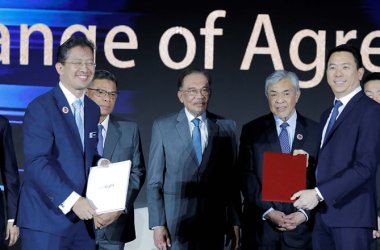
Dubai — TP-Link is setting bold benchmarks for innovation in 2025, reshaping the future of connectivity and security. The company’s strategic roadmap includes the rollout of a comprehensive Wi-Fi 7 portfolio and AI-optimised network management to game-changing surveillance advancements with solar-powered VIGI devices and Omada’s centralised systems.
In an exclusive interview with Tahawultech.com, Lucas Jiang, General Manager of TP-Link MEA, shares TP-Link’s vision for transforming connectivity, empowering channel partners, and driving digital transformation across the Middle East and Africa. With an emphasis on empowering channel partners, driving sustainability, and expanding across the Middle East and Africa, Jiang explains how TP-Link is making cutting-edge technology more accessible while solidifying its position as a leader in secure, scalable networking solutions.
Interview excerpts:
How does TP-Link’s Wi-Fi 7 technology enhance connectivity, and what challenges do you foresee in its adoption across the MEA region?
TP-Link’s Wi-Fi 7 technology brings groundbreaking advancements in wireless networking, set to transform connectivity experiences. We take great pride in being the first vendor to launch a complete range of Wi-Fi 7 solutions for both home and enterprise environments.
The Wi-Fi 7 technology brings significant improvements in speed, latency, and network capacity. It delivers ultra-fast data rates of up to 46 Gbps—nearly 4.8 times faster than Wi-Fi 6—thanks to 320 MHz bandwidth and 4096-QAM modulation, ideal for HD streaming, gaming, and smart homes. Latency is reduced by up to four times, enabling real-time performance for VR and interactive applications. Additionally, Multi-Link Operation (MLO) boosts network capacity and efficiency by handling multiple data streams across frequency bands, making it ideal for device-dense environments like offices and public spaces.
The adoption of Wi-Fi 7 technology across the Middle East and Africa (MEA) region faces several challenges. One of the primary hurdles is infrastructure limitations, as many areas still lack the robust telecommunications framework needed to support high-speed connectivity. This shortfall makes the deployment of advanced technologies like Wi-Fi 7 difficult. Economic disparities also play a significant role, with the high costs of implementation and operation potentially restricting access in regions where disposable incomes are lower. Additionally, regulatory considerations impact the rollout, as the availability of the 6 GHz frequency band—crucial for Wi-Fi 7’s performance—differs from country to country, depending on local spectrum policies and approvals. Finally, market awareness remains a key issue; without sufficient education on the benefits of Wi-Fi 7, both consumers and businesses may be hesitant to upgrade, leading to a slower rate of adoption across the region.
How does Omada’s flexible management architecture cater to enterprise networking needs, and what sets it apart from competitors?
Omada’s flexible management architecture is tailored to meet the varied networking needs of modern enterprises by offering a robust and intelligent approach to network administration. At the core of its solution is centralised cloud management, powered by a Software-Defined Networking (SDN) platform that seamlessly integrates access points, switches, and routers to ensure unified control over both wireless and wired connections. Omada also features zero-touch provisioning, enabling remote deployment and configuration without the need for on-site technical support—significantly simplifying setup and reducing operational costs. Additionally, the platform leverages AI-driven technology to analyse network performance, offer optimisation recommendations, and proactively resolve potential issues, thereby boosting network efficiency and ensuring consistent reliability.
TP-Link’s Omada distinguishes itself in the competitive networking solutions market through a range of standout features tailored for flexibility, efficiency, and security. One of its key advantages is flexible management options—users can manage their networks without the need for a dedicated controller, choosing between hardware controllers, software controllers, or cloud-based management. This approach allows businesses to customise their setup according to their needs while avoiding unnecessary subscription costs. Omada’s unified network architecture further simplifies operations by enabling centralised management of WAN, LAN, and wireless components through a single platform, enhancing overall efficiency.
Its comprehensive cloud-based management capabilities allow administrators to remotely monitor and configure networks using the Omada Cloud-Based Controller. Tools like batch configuration, multi-site management, and remote firmware updates streamline day-to-day network maintenance. Security and reliability are also at the forefront of Omada’s offering—the system ensures that user traffic does not pass through the cloud, maintaining data privacy, while delivering 99.9% SLA availability, 24/7 automated fault detection, and backup servers in geographically isolated locations for added reliability. Finally, AI-driven network optimisation equips IT teams with proactive insights, such as automatic channel selection and power adjustment, helping reduce interference and significantly boosting wireless network performance.
With cybersecurity being a major concern, how does Omada ensure secure and scalable network management for businesses?
TP-Link’s Omada platform is designed to provide businesses with secure and scalable network management, integrating advanced security measures, independent verification, and a forward-looking approach to continuous improvement. At the heart of this solution lies a comprehensive security framework, which is central to TP-Link’s product strategy. Omada is built to anticipate, identify, and respond to risks effectively through internal penetration testing, real-world threat modeling, and adherence to industry standards like the OWASP IoT Top 10, ensuring resilience against ever-evolving cyber threats.
Security assurance is further reinforced through rigorous internal and external assessments. TP-Link collaborates with accredited third-party security labs to examine Omada products, ensuring any vulnerabilities are addressed proactively. Public security data shows that TP-Link maintains vulnerability rates that are equal to or lower than other industry leaders, underscoring its strong commitment to robust cybersecurity practices.
As a strong proponent of the secure-by-design philosophy, TP-Link actively supports global security initiatives, including the U.S. Cyber Trust Mark and the EU’s Cyber Resilience Act. These frameworks guide Omada’s development process, ensuring transparency through Software Bills of Materials (SBOMs) and alignment with top-tier industry standards.
Omada also prioritises proactive threat mitigation and transparency. Businesses receive timely firmware updates and critical security advisories, along with clear end-of-life policies to ensure continued support. The platform’s cloud-based centralised management system further enhances protection by isolating management data from user traffic.
Engagement with the global cybersecurity community is another pillar of TP-Link’s strategy. Through its vulnerability disclosure program and participation in initiatives like PWN2OWN, TP-Link ensures fast responses—typically within five working days—to any reported issues, continuously testing and improving Omada’s defenses.
Omada’s strength also lies in TP-Link’s CI/CD development approach, which integrates security at every stage of the lifecycle. This enables early detection and resolution of potential vulnerabilities while ensuring scalability, high availability, and rapid response to threats. By embedding security into its core and staying closely aligned with industry best practices, TP-Link has positioned Omada as a reliable, future-ready solution for secure business network management.
What makes VIGI a standout surveillance solution, and how does it integrate with modern security ecosystems?
VIGI emerges as a powerful, AI-enhanced, and cost-effective surveillance solution designed to meet the evolving security needs of modern businesses. Its ease of deployment, scalability, and compatibility with current security ecosystems make it a future-ready choice for seamless and intelligent security management. With advanced features like AI-powered analytics, ONVIF support, Omada SDN integration, and industry-leading warranty services, VIGI offers a comprehensive and reliable approach to surveillance.
At the core of its capabilities are AI-powered analytics. VIGI cameras utilise advanced AI chips and deep-learning algorithms to monitor live footage in real time, detect unusual events, and send immediate alerts. This intelligent approach significantly reduces false alarms and enhances response times, improving overall security effectiveness. In addition, VIGI’s ColorPro Night Vision technology ensures sharp, full-color images even in extremely low-light conditions, enabling round-the-clock surveillance with exceptional clarity.
VIGI also offers flexible management options through both standalone setups and centralised Video Management Systems (VMS). The VMS enables unified control over multiple devices, streamlining operations and providing user-friendly access across different sites. For broader compatibility, VIGI supports the ONVIF protocol, allowing integration with a wide range of third-party NVRs and VMS platforms, ensuring seamless interoperability in diverse security environments.
Moreover, VIGI is designed to integrate effortlessly with TP-Link’s Omada Software-Defined Networking (SDN) ecosystem. This compatibility allows centralised monitoring of both surveillance and enterprise network infrastructure, with Power over Ethernet (PoE) support simplifying installation and connectivity. Businesses also benefit from the VIGI Cloud VMS, a cloud-hosted platform that offers centralised control via web portals, mobile apps, and PC clients—ideal for managing security across multiple locations.
By combining AI intelligence, superior night vision, versatile management tools, and strong integration capabilities, VIGI positions itself as a smart, scalable, and future-proof surveillance solution tailored for modern businesses.
What are TP-Link MEA FZE’s key innovations and strategic plans for networking and surveillance solutions in 2025?
In 2025, TP-Link is set to transform connectivity and security with the full launch of its Wi-Fi 7 and MGIG solutions, catering to both home users and businesses, especially SMEs and large enterprises. These offerings promise ultra-fast speeds, reliable connectivity, and unified network performance across all user segments.
TP-Link is also integrating AI-driven technology across its product line to enhance network performance. These AI-enhanced systems will automatically optimise traffic, troubleshoot issues, and strengthen security, creating efficient, self-managing networks for homes and businesses alike.
“On the surveillance front, TP-Link’s VIGI portfolio introduces innovations like solar-powered, 5G-connected security devices, enabling flexible, sustainable installations without traditional wiring. A highlight is the InSight S345-4G device with three LAN ports for efficient multi-device connectivity.”
Additionally, Omada Central offers centralised management of both networking and surveillance systems, simplifying operations for SMEs by enabling unified control across multiple sites. Together, VIGI and Omada Central deliver a powerful combination of intelligent security and seamless connectivity, making TP-Link a leader in next-generation networking and surveillance solutions.
What are TP-Link’s strategic plans for expanding its presence in the Middle East and Africa (MEA) in 2025?
In 2025, TP-Link is focusing on expanding its footprint across the MEA region by strengthening partnerships with local distributors and increasing its presence in smaller cities and rural areas. This strategic effort aims to make high-performance, affordable networking solutions accessible to a broader audience, especially small and medium-sized businesses (SMBs), and support digital transformation in underserved regions.
How does TP-Link support its channel partners in keeping up with evolving technology?
TP-Link places a strong emphasis on partner empowerment through structured training and hands-on technical learning. Recognising the rapid pace of digital innovation, TP-Link ensures that distributors and channel partners are well-equipped with the latest knowledge and skills. By offering immersive training programs, TP-Link enables partners to confidently implement and support advanced solutions such as Wi-Fi 7 and VIGI surveillance systems, building trust and fostering long-term collaboration.
What role does sustainability play in TP-Link’s 2025 strategy?
Sustainability is a key component of TP-Link’s 2025 vision. The company is integrating energy-saving technologies into its product designs to reduce carbon footprints and improve energy efficiency. With increasing global awareness around environmental issues, TP-Link aims to lead the way in offering eco-friendly networking solutions suitable for both personal and professional use.
What steps is TP-Link taking to ensure the security of its networking and IoT products?
Security is a top strategic priority for TP-Link. The company employs rigorous internal and external testing—including penetration tests and threat modeling—to secure its devices. TP-Link demonstrates fewer vulnerabilities and faster resolution times compared to industry peers. It also supports global security initiatives like the EU Cyber Resilience Act, U.S. Cyber Trust Mark, and the “Secure by Design” pledge. Transparency is maintained through Software Bills of Materials (SBOMs) and regular firmware updates, and the CI/CD development model ensures rapid threat response and customer trust.
How does TP-Link engage with the broader security community?
TP-Link actively collaborates with the cybersecurity community through its vulnerability disclosure program and participation in security events such as PWN2OWN. These engagements help the company stay ahead of emerging threats, reinforce its security posture, and uphold its reputation as a trusted leader in networking and IoT security.





